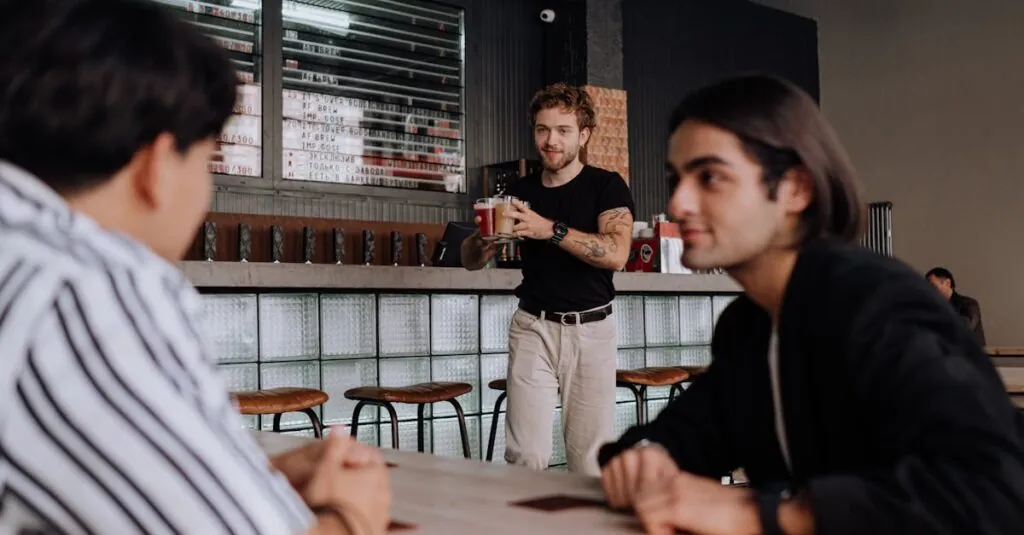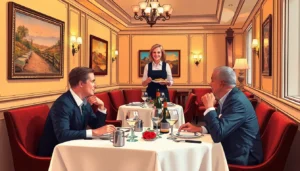Picture this: you walk into a bustling bar, the air thick with laughter and the clinking of glasses. You approach the bar, and suddenly, you’re not just a customer; you’re a star in a one-act play where the bartender is both the director and the lead. Bartender interaction isn’t just about ordering drinks; it’s a delightful dance of wit, charm, and sometimes, a splash of chaos.
Understanding Bartender Interaction
Bartender interaction creates a unique experience that enhances the social atmosphere of any bar. Engaging with the bartender often sets the tone for the entire visit. Customers frequently appreciate a friendly greeting, sparking a sense of warmth and welcome. The bartender’s ability to read the room contributes significantly to the overall vibe.
Responses to customer queries often blend humor and knowledge, captivating patrons’ attention. Patrons enjoy swapping stories, forging connections that transcend mere transactions. Conversations can range from drink recommendations to discussions about local events.
Banter plays a crucial role in these interactions. A witty remark or playful tease can instantly uplift spirits and encourage laughter. Customers often return to bars, seeking not just a drink but also the familiarity of these exchanges.
Personalized service enhances the connection between bartender and patron. Remembering regulars’ names or favorite orders shows attention to detail and cultivates loyalty. Each interaction becomes part of an ongoing narrative, with the bartender acting as a storyteller.
Efficient communication impacts the flow of service. Bartenders must balance attentiveness with speed, ensuring no patron feels neglected. By maintaining a seamless dialogue, they elevate the experience for everyone.
These interactions serve to create an engaging environment where everyone feels involved. A well-timed compliment or a shared laugh can make all the difference in a crowded bar. Ultimately, bartender interaction transforms a simple drink order into a memorable part of the nightlife experience.
Importance of Bartender Interaction
Bartender interaction plays a crucial role in creating an enjoyable bar experience. Engaging with bartenders enhances the atmosphere, making visits more memorable.
Customer Experience
Immediate connection with bartenders can significantly elevate customer satisfaction. When guests receive personalized greetings, it sets a positive tone for their visit. Drinks crafted with care often lead to positive reviews. Quick and attentive service keeps patrons coming back. Guests appreciate bartenders who can recommend drinks tailored to their tastes. These interactions foster a fun environment, transforming simple visits into social experiences.
Building Rapport
Establishing rapport between bartenders and customers leads to lasting relationships. Frequent patrons often enjoy a sense of belonging when bartenders remember their names and preferences. Such familiarity enhances loyalty, encouraging customers to return. Conversational exchanges can lead to friendships that extend beyond the bar. Sharing stories and banter builds community among patrons, creating an inviting atmosphere. Personal touches in service make each visit feel special and unique.
Types of Bartender Interactions
Bartender interactions encompass various styles, each contributing uniquely to the customer experience. Understanding these types enhances appreciation of the dynamic social environment in bars.
Conversational Engagement
Conversational engagement thrives on witty exchanges and personalized dialogue. Bartenders often initiate conversations by asking patrons about their day or drink preferences. This approach creates an open environment for friendly banter, inviting patrons to join in. Moreover, engaging discussions about cocktail choices or local events foster a deeper connection. Skilled bartenders utilize humor to lighten the mood and cultivate rapport. As customers respond with stories or jokes, the atmosphere becomes lively and intimate. Frequent patrons often benefit from connections formed through shared conversations, transforming their visits into enjoyable experiences. Ultimately, this interaction type elevates the bar’s ambiance, encouraging a sense of community.
Non-Verbal Communication
Non-verbal communication plays a pivotal role in bartender interactions. Body language conveys enthusiasm and approachability, inviting patrons to feel comfortable. A smile, eye contact, or nod can create immediate warmth. Bartenders utilize efficient movements while mixing drinks, enhancing the overall experience. Quick gestures demonstrate attentiveness, showing that they value their patrons’ needs. Additionally, non-verbal cues, such as a raised hand for service or a friendly wave, maintain engagement even during busy periods. This form of communication complements verbal exchanges, enriching the patron experience. Strong non-verbal skills often mark exceptional bartenders, establishing rapport that keeps customers returning for more.
Factors Influencing Bartender Interaction
Bartender interaction heavily relies on various factors. Understanding these elements enhances the customer experience.
Environment and Atmosphere
The bar’s environment significantly shapes interactions. An inviting atmosphere encourages conversation, while dim lighting can create intimacy. Background music also plays a role. Upbeat tunes foster a lively mood, prompting bartenders to engage playfully with patrons. Additionally, the layout impacts interactions; an open design invites social exchanges, whereas a cramped setting may inhibit them. Seasonal decorations can further influence interactions, creating a festive vibe that encourages sharing. Overall, a vibrant atmosphere enhances the charm of bartender interactions.
Bartender Personality
Bartender personality traits directly affect how patrons connect. A friendly demeanor invites warmth, while humor adds to the entertainment. Knowledgeable bartenders engage customers with insights about drinks, creating a rich dialogue. Charisma attracts patrons, making them feel valued and understood. Additionally, adaptability is essential; bartenders who read the room can adjust their approach to fit different patron moods. Passion for mixology can spark enthusiastic discussions about cocktails, enriching the interaction. Ultimately, a bartender’s unique personality enhances the overall experience, fostering lasting memories.
Bartender interactions play a pivotal role in shaping the overall bar experience. They transform a simple drink order into an engaging social event that fosters connection and community. The blend of humor, personality, and attentive service creates a warm atmosphere where patrons feel valued and appreciated.
These interactions not only enhance customer satisfaction but also encourage loyalty, turning casual visitors into regulars. As bartenders skillfully navigate conversations and non-verbal cues, they cultivate an inviting space that resonates with the vibrant energy of nightlife.
Ultimately, the magic of bartender interaction lies in its ability to create memorable moments that linger long after the last drink is served.





